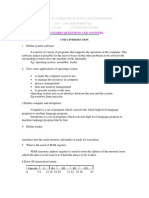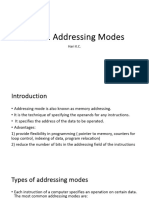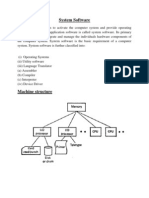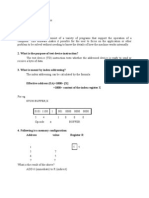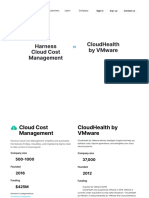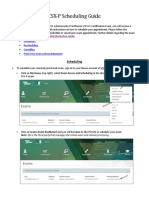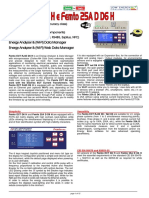System Software Two Marks
System Software Two Marks
Uploaded by
Keerthi VasanCopyright:
Available Formats
System Software Two Marks
System Software Two Marks
Uploaded by
Keerthi VasanCopyright
Available Formats
Share this document
Did you find this document useful?
Is this content inappropriate?
Copyright:
Available Formats
System Software Two Marks
System Software Two Marks
Uploaded by
Keerthi VasanCopyright:
Available Formats
SYSTEM SOFTWARE PART- A UNIT I What is System Software?
System Software consists of a variety of programs that support the operation of a computer. It makes possible for the user to focus on an application or other problem to be solved, without needing to know the details of how the machine works internally. Define Assembler
Assemblers translate mnemonic instructions into machine code, the instruction formats, addressing modes, etc., are of direct concern in assembler design. Define Compiler.
Compiler translate the high level programs into machine language, taking into account such hardware characteristics as the number and type of registers & machine instruction available. Define Loader and Linker.
The resulting machine language program was loaded in memory and prepared for execution by loader and linker. What are the registers are available for SIC machine? Number 0 Special Use
Mnemonic A X L PC SW
Accumulator, used for arithmetic operations 1 Index register, used for Addressing 2 Linkage register, the jump to subroutine instruction stores the return address in this register. 8 Program counter, contains the address of the next instruction to be fetched for execution. 9 Status word, contains a variety of information, including a Condition Code. Write about different addressing modes in SIC machine.
There are two addressing modes, indicated by the setting of the x bit in the instruction. Target Address Calculation Mode Direct Indirect x=0 x=1 Indication Target Address Calculation TA= address TA= address + (X)
Parentheses are used to indicate the contents of a register or a memory location. For example, (X) represents the contents of register X. What are the registers are available for SIC/XE machine? In Addition to the SIC registers Mnemonic B S T F Number 3 4 5 6 Special Use Base register, used for addressing General working register-no special use. General working register-no special use. Floating point accumulator
Write down the instruction formats of SIC/XE machine.
There are two possible options- use relative addressing or extend the address field to 20 bits. In addition, SIC/XE provides some instructions that do not reference memory at all. Formats 1 and 2 are used for such instructions. Formats 3 & 4 are used for new set of instruction. If bit e=0 means format 3 and e=1 means format 4.
Format 1 (1 byte) 8
op Format 2 (2 bytes) 8 op r1 4 r2 4
Format 3 (3 bytes) 6 op 1 1 1 1 1 1 n i x b p e 12 disp
Format 4 (4 bytes) 6 op 1 1 1 1 1 1 n i x b p e address 20
List down the addressing mode of SIC/XE and explain it.
Addressing Modes Mode Indication TargetAddress Calculation TA= (B) + disp TA= (pc)+ disp
Base relative b=1,p=0 Program counter b=0,p=0 relative
Base Relative Addressing The disp in format 3 is interpreted as a 12 bit unsigned integer. Program counter relative addressing The disp field is interpreted as a 12 bit signed integer, with ve values represented in 2s complement notation.
For format 3 both b and p are set to 0,disp field is taken to be the target address. For format 4 both b and p are set to 0, the target address is taken from the address field. This is Direct Addressing. Indexed Addressing Any of these addressing mode is combined with indexed addressing if bit x=1, the term (X) is added to target address. Immediate Addressing For format3 & 4 If Bit i=1 & n=0, the target address itself is used as the operand value, no memory reference is performed. Indirect Addressing If Bit i=0 & n=1, the value contained in this word is then as the address the operand value. Simple Addressing If Bit i=0 & n=0 or i=1 & n=1, the target address is taken as the location of the operand. Write a SIC program to perform an arithmetic operations. Refer notes.
What is Virtual address space?
Virtual memory allows programs to operate as though they had access to an extremely large memory, regardless of the amount of memory actually present on the system. Routines in the operating system take care of the details of memory management. Explain the data formats of VAX machine.
Integers are stored as binary numbers in a byte, word, longword, quadword or octaword.
2s complement representation is used for negative values. Characters are stored using their 8- bit ASCII codes. Four different floating point data formats on the VAX, ranging in length from 4 to 16 bytes. Two of these are compatible with those found on the PDP-11 and are standard on all VAX processors. The other two are available as options. VAX processors provide a packed decimal data format. In this format each byte represents two decimal digits, with each digit encoded using 4 bits of the byte. The sign is encoded in the last 4 bits. Numeric format that is used to represent values with one digit per byte. In this format, the sign may appear either in the last byte or as a separate byte preceding the first digit. These two variations are called trailing numeric and leading separate numeric. VAX also supports data structures, such as these can be implemented on any machine. VAX provide direct hardware support for them. List down the addressing mode of VAX and explain it.
VAX provides a large number of addressing modes. The operand itself may be in a register or its address may be specified by register (register mode). If the operand address is in a register, the contents of the register may be automatically incremented and decremented by the operand length (autoincrement and autodecrement mode). There are several base relative addressing modes, with displacement fields of different length, when used with register PC, they become program counter relative modes. Describe how instruction sets are designed in VAX.
One of the goals of the VAX designers was to produce an instruction set that is symmetric with respect to data type. Many instruction mnemonics are formed by combining the following elements 1. A prefix that specifies the type of operation 2. A suffix that specifies the data type of the operands 3. A modifier that gives the number of operands involved. Ex., ADDW2 is an add operation with two operands, each a word in length. VAX provides all of the usual types of instructions for computation, data movement, etc., There are also powerful instructions for calling and returning from procedures. How input and output operations are performed in VAX?
Input and output on the VAX are accomplished by I/O device controllers. Each controller has a set of control/status and data registers, which are signed locations in the physical address space. The portion of the address space into which the device controller registers are mapped is called I/O space. No special instructions are required to access register in I/O space. I/o device driver issues command to device controller by storing values in the appropriate registers. The association of an address in I/O space with a physical register in a device controller is handled by the memory management routines. Note: Similar patterns are expected for the other machines. Compare RISC and CISC. CISC: 1. Complex instruction Set Computer. 2. It supports complex instruction set and its of variable length. 3. Examples:VAX Architecture, Pentium Pro Architecture RISC: 1.Reduced instruction set Computer 2.It supports reduced instruction set and its of fixed length. 3.Example:ultraSPARC,PowerPc,Cray T3E Architectures. Consider the following settings: (B) = 006000, (PC)=003000, (X)=000090 N = 1; i=1; x=0; b=0; p=1; e=0; disp. Address = 0110 0000 0000. Calculate TA. TA = 3000+600 = 3600 Write a program for multiplication of two numbers (SIC). Refer Page No. 1 of Unit IV(System Software Notes).
You might also like
- (K3A, K5A) Kisan User Manual (v1.00) EngDocument11 pages(K3A, K5A) Kisan User Manual (v1.00) EngKoffi Olivier N'kounouNo ratings yet
- Assembly Programming:Simple, Short, And Straightforward Way Of Learning Assembly LanguageFrom EverandAssembly Programming:Simple, Short, And Straightforward Way Of Learning Assembly LanguageRating: 5 out of 5 stars5/5 (2)
- FortiOS 7.2 Best - PracticesDocument43 pagesFortiOS 7.2 Best - PracticesMichael Fabian Rennella MuñozNo ratings yet
- System Software and Machine Architecture Introduction2Document3 pagesSystem Software and Machine Architecture Introduction2SathyapriyaNo ratings yet
- Data AnaDocument12 pagesData AnaranjithkumargruNo ratings yet
- System Software - Unit IDocument77 pagesSystem Software - Unit IJASPER WESSLYNo ratings yet
- Ssos - U1-23Document62 pagesSsos - U1-23fayazahamed024No ratings yet
- AnnaDocument73 pagesAnnaDriti DasNo ratings yet
- University Solved Answers Unit 1 SS (System Software Notes)Document12 pagesUniversity Solved Answers Unit 1 SS (System Software Notes)Vaishnavi Rave100% (1)
- Unit 2 CaoDocument8 pagesUnit 2 CaoZamal AhmedNo ratings yet
- 2 MarksDocument17 pages2 MarksGeetha ParthibanNo ratings yet
- Coal HandoutsDocument18 pagesCoal HandoutsSaeNo ratings yet
- System SoftwareDocument17 pagesSystem Softwaremandalapu_devi5240No ratings yet
- Lecture#2 Fut Microprocessor PDFDocument81 pagesLecture#2 Fut Microprocessor PDFAhmedGamalNo ratings yet
- Unit - I: Cs2304-System SoftwareDocument10 pagesUnit - I: Cs2304-System SoftwareNandha KumarNo ratings yet
- 2 Marks Que &ansDocument30 pages2 Marks Que &ansKanthimathi SureshNo ratings yet
- University of Negros Occidental Recoletos Cpecso34P Computer Organization With Assembly Language Laboratory #4Document11 pagesUniversity of Negros Occidental Recoletos Cpecso34P Computer Organization With Assembly Language Laboratory #4jamming jamNo ratings yet
- Chapter 3Document48 pagesChapter 3Aman Ethio LijNo ratings yet
- cs2304 System Software 2 Marks and 16 Marks With AnswerDocument18 pagescs2304 System Software 2 Marks and 16 Marks With Answermanojkumar024No ratings yet
- Architectures NotesDocument9 pagesArchitectures Notesvamsi.d124No ratings yet
- Syssoft 1Document19 pagesSyssoft 1api-3826913No ratings yet
- Ss 1Document78 pagesSs 1NithiBoazNo ratings yet
- System Software and Compiler DesignDocument34 pagesSystem Software and Compiler Designsourabha DNo ratings yet
- Coen3114 Intro To Assembly Language Programming PDFDocument80 pagesCoen3114 Intro To Assembly Language Programming PDFjocansino4496No ratings yet
- 3 8086 InstructionsDocument135 pages3 8086 Instructionssakshammahajan24303No ratings yet
- SsDocument60 pagesSsponns100% (1)
- CA Classes-36-40Document5 pagesCA Classes-36-40SrinivasaRaoNo ratings yet
- MASM1Document29 pagesMASM1harshasrivardhankapa9No ratings yet
- Assembly Language Lab-1Document6 pagesAssembly Language Lab-1mudassar87No ratings yet
- Architecture of Computers Lab1Document28 pagesArchitecture of Computers Lab1q5nfvkbyyrNo ratings yet
- Archi FinalDocument24 pagesArchi Final422p5t5c66No ratings yet
- CH 5 OnDUPdated UNit 4 Addressing ModesDocument46 pagesCH 5 OnDUPdated UNit 4 Addressing ModesSujan TimalsinaNo ratings yet
- Fundamentals of Computer Organization and Digital ElectronicsDocument93 pagesFundamentals of Computer Organization and Digital ElectronicsGogNo ratings yet
- CS1203 System Software UNIT I Question AnsDocument10 pagesCS1203 System Software UNIT I Question AnskeerthisivaNo ratings yet
- Unit 2Document24 pagesUnit 2zccoffin007No ratings yet
- SSCD Mod 1Document25 pagesSSCD Mod 1vickyNo ratings yet
- System Software and Compilers PDFDocument199 pagesSystem Software and Compilers PDFPrathiksha B.ANo ratings yet
- Unit VDocument42 pagesUnit VThenmozhi ElumalaiNo ratings yet
- 06 Unit 3Document52 pages06 Unit 3Hasrulnizam HashimNo ratings yet
- Unit IV Computer ArchitectureDocument18 pagesUnit IV Computer Architecturevaishnavi sharmaNo ratings yet
- MSI Lab Lecture 1-2Document32 pagesMSI Lab Lecture 1-2Ahmed DaudNo ratings yet
- Module 5 Assembly Level LanguageDocument20 pagesModule 5 Assembly Level Languageakashi seijuroNo ratings yet
- System SoftwareDocument8 pagesSystem SoftwareSakshi JunejaNo ratings yet
- Viva Voce Questions With AnswersDocument18 pagesViva Voce Questions With AnswersHari67% (18)
- Short Questions and AnswersDocument12 pagesShort Questions and Answersrochakjyoti100% (2)
- 04 8051 Instruction SetDocument76 pages04 8051 Instruction SetharinkhedetNo ratings yet
- Group 6 Cpu Design PresentationDocument50 pagesGroup 6 Cpu Design PresentationFerry AriNo ratings yet
- SS Question BankssDocument72 pagesSS Question BankssAdvika RoyNo ratings yet
- cs2304 NolDocument49 pagescs2304 NolAlex DavidNo ratings yet
- Lab 2Document10 pagesLab 2waleedNo ratings yet
- CISCDocument16 pagesCISCAnonymous OQxVUBZVNo ratings yet
- Lab 02: Getting Started With Turbo Assembler (TASM) : Objective(s)Document10 pagesLab 02: Getting Started With Turbo Assembler (TASM) : Objective(s)Google UserNo ratings yet
- Assembly Language: by - Prof. Prithi K.SDocument67 pagesAssembly Language: by - Prof. Prithi K.SprithiksNo ratings yet
- Lec 03 Internal Micro ArchitectureDocument24 pagesLec 03 Internal Micro ArchitecturePaarth JamwalNo ratings yet
- 02 SIC XE MachineDocument38 pages02 SIC XE MachineahmedNo ratings yet
- Computer Architecture and PeripheralsDocument45 pagesComputer Architecture and PeripheralsthisistherobbaryNo ratings yet
- Lecture 2Document27 pagesLecture 2Muhammad WasayNo ratings yet
- Unit 2Document49 pagesUnit 2ladukhushi09No ratings yet
- System Software NotesDocument104 pagesSystem Software NotesVishal PatelNo ratings yet
- Exp - Learning - Task2 - Savani - DhruvDocument5 pagesExp - Learning - Task2 - Savani - DhruvGauravCherukuriNo ratings yet
- Practical Reverse Engineering: x86, x64, ARM, Windows Kernel, Reversing Tools, and ObfuscationFrom EverandPractical Reverse Engineering: x86, x64, ARM, Windows Kernel, Reversing Tools, and ObfuscationNo ratings yet
- Harness CloudHealth by VMware Vs Harness DevOps Tools ComparisonDocument9 pagesHarness CloudHealth by VMware Vs Harness DevOps Tools Comparisongeorgy.vacadzeNo ratings yet
- Tables SapDocument21 pagesTables SapLos VizuetinesNo ratings yet
- Lecture01 NoteDocument27 pagesLecture01 NoteJibril JundiNo ratings yet
- Datasheet LINEARdrive 100D 180D 720D V4 - 5Document2 pagesDatasheet LINEARdrive 100D 180D 720D V4 - 5Firda NatalieNo ratings yet
- CAN Bus Troubleshooting GuideDocument7 pagesCAN Bus Troubleshooting GuideStephano Guanilo BrionesNo ratings yet
- Mysql Connector/Odbc Developer GuideDocument106 pagesMysql Connector/Odbc Developer Guidejosecarlos.linaresNo ratings yet
- ELECTRICITY BILL MANAGEMENT SYSTEMddddddddddddDocument13 pagesELECTRICITY BILL MANAGEMENT SYSTEMddddddddddddAshish MOHARENo ratings yet
- Worksheet 3.2 An Introduction To HTTPDocument14 pagesWorksheet 3.2 An Introduction To HTTPOscarinho OrtizNo ratings yet
- IC5100 / Flex5100: #Jufmibtbwbsjfuzpgqbznfoutpmvujpot UpcfpggfsfeupjuthmpcbmdmjfoutDocument2 pagesIC5100 / Flex5100: #Jufmibtbwbsjfuzpgqbznfoutpmvujpot UpcfpggfsfeupjuthmpcbmdmjfoutSayed Ibrahim GhanemNo ratings yet
- Interrup C I OnesDocument46 pagesInterrup C I OnesJean Paul LoayzaNo ratings yet
- Ticketing Tool 1Document5 pagesTicketing Tool 1swetha devarakondaNo ratings yet
- M.Tech.: Data Science & EngineeringDocument20 pagesM.Tech.: Data Science & EngineeringNEHA BANSALNo ratings yet
- Fundamentals of Database Systems: Lesson 1: IntroductionDocument35 pagesFundamentals of Database Systems: Lesson 1: IntroductionPhạm Trung MinhNo ratings yet
- Practical File: Computer ScienceDocument35 pagesPractical File: Computer Sciencer10943700No ratings yet
- Critical Review of Vendor Lock-In and Its Impact On Adoption of Cloud ComputingDocument6 pagesCritical Review of Vendor Lock-In and Its Impact On Adoption of Cloud ComputingGabrieleNo ratings yet
- What Is A Domain Name SystemDocument3 pagesWhat Is A Domain Name SystemForsep wickiNo ratings yet
- GCP Digital Leader-2ndfileDocument16 pagesGCP Digital Leader-2ndfilesaiNo ratings yet
- CNCC Question Bank MRM 2K22Document7 pagesCNCC Question Bank MRM 2K22Dayana dossNo ratings yet
- Magic Maths System - Srs-IeeeDocument37 pagesMagic Maths System - Srs-IeeeNoName KnightNo ratings yet
- Clarion Latin America - NX700 Software Update For BluetoothDocument4 pagesClarion Latin America - NX700 Software Update For BluetoothalauriNo ratings yet
- External SortingDocument5 pagesExternal SortingXYZ ABCDNo ratings yet
- Boosting Cache Performance by Access Time Measurements: Gil Einziger, Omri Himelbrand, Erez WaisbardDocument29 pagesBoosting Cache Performance by Access Time Measurements: Gil Einziger, Omri Himelbrand, Erez WaisbardMuhammad Khaleel AfzalNo ratings yet
- Certifications CSXP Scheduling GuideDocument13 pagesCertifications CSXP Scheduling Guidejesus_yustasNo ratings yet
- V4.5 AllGoVision Datasheet LicensePlateRecognitionDocument12 pagesV4.5 AllGoVision Datasheet LicensePlateRecognitionJrGomesNo ratings yet
- Data Sheet Femto ECT D6 e Femto 25A D D6Document12 pagesData Sheet Femto ECT D6 e Femto 25A D D6Raj KolankiNo ratings yet
- Cics QDocument14 pagesCics QRamanuj BhardwajNo ratings yet
- System Galaxy Quick Guide: OTIS Compass Elevator SystemDocument61 pagesSystem Galaxy Quick Guide: OTIS Compass Elevator Systemcatherine mifsudNo ratings yet
- Re - (Packetfence-Users) Packetfence & Nessus Configuration - PacketFenceDocument17 pagesRe - (Packetfence-Users) Packetfence & Nessus Configuration - PacketFenceamougoumgbwaNo ratings yet















